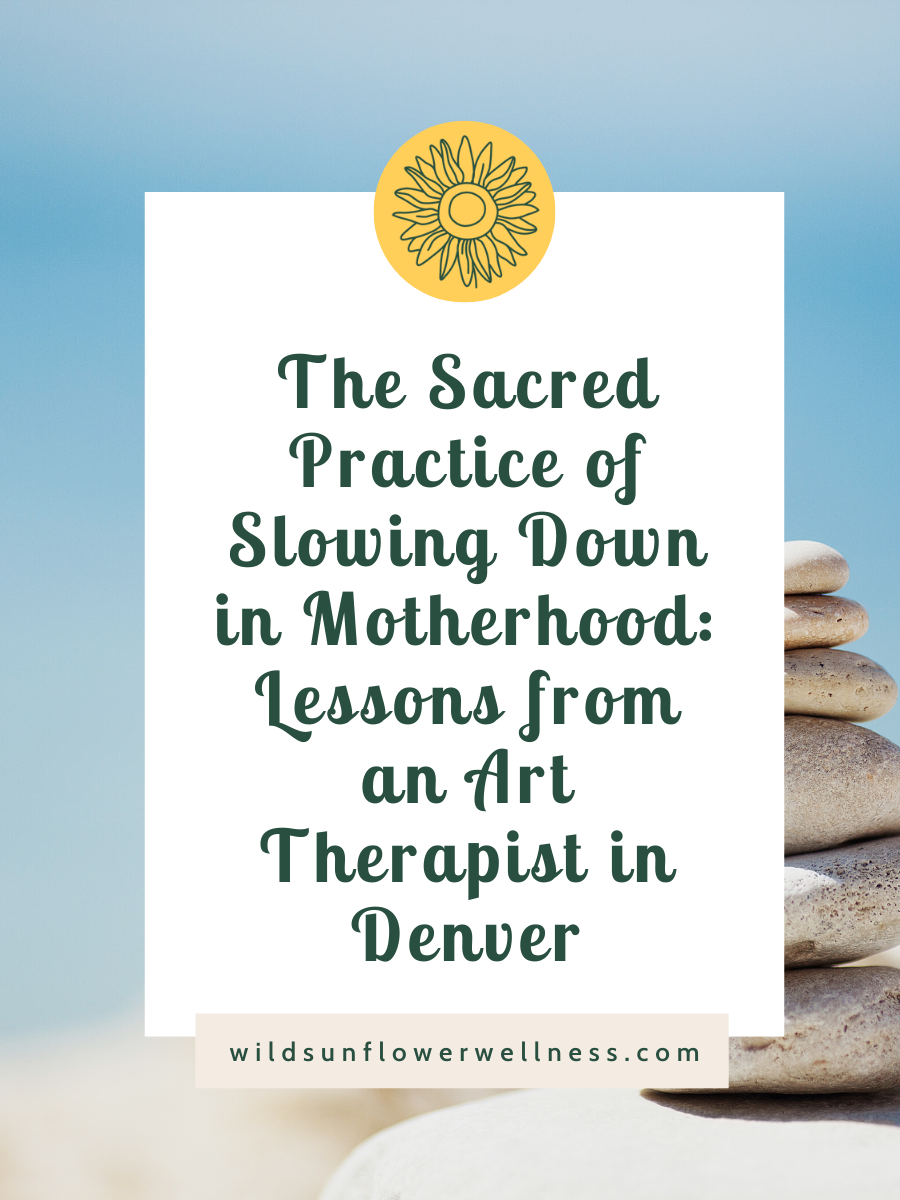The Sacred Practice of Slowing Down in Motherhood: Lessons from an Art Therapist in Denver
I still remember the shock of becoming a first-time mom in the height of the COVID-19 pandemic, how lonely it felt to cross the threshold into motherhood without a community to hold me. It was overwhelming, defeating and disorienting.
Like so many new mothers, I turned to my phone, the internet, and social media, hoping to create the sense of connection I so desperately craved. But instead of filling me up, it gave me only a false sense of community—one that left me feeling even more isolated and hollow.
It wasn’t until I began slowing down, returning to my art practice and intentionally seeking out in-person community, that I found my way back home to myself. Over time, I’ve come to see that slowing down is more than just a pause. For me, it has become a sacred practice—one that gently reconnects mind, body, and spirit.
The Myth of “Faster is Better”
Motherhood has a way of exposing the cultural myths we didn’t even know we were living by. Before I became a mom, moving quickly through life felt natural. I thrived in a society that values productivity and achievement, and I was rewarded when I fit the mold. Anyone else?
But motherhood doesn’t fit that mold. It’s messy, unpredictable, and there’s no gold star waiting on the other side of your accomplishments. Still, so many of us feel the pressure to keep up—to heal faster, to quickly figure out who we are as mothers, to rush our children through milestones. This conditioning whispers that “faster is better,” and if we’re not careful, it can seep into the most sacred parts of motherhood.
The Choice to Resist the Myth
Once I became aware of the myths I was reinforcing, I could begin to make a different choice—for myself, my motherhood, and my children’s childhood. Awareness creates the opening; choice deepens it.
When we begin to gently release the story that our value lies in speed, productivity, and achievement, we allow room for something else: connection, presence, and healing. This doesn’t happen overnight, and it doesn’t mean life suddenly feels easier. But it does mean that we can pause long enough to ask: What is actually nourishing me? What pace feels sustainable?
Resisting the myth of “faster is better” is an act of care—for ourselves and for the ones we love. And the more we practice slowing down, the more we remember that worthiness was never tied to speed in the first place.
What Art Taught Me About Slowing Down
As an art therapist in Denver who works with women and moms, I’ve learned that art is one of the best teachers of slowing down. Observation is at the heart of my work. It requires patience, presence, and noticing the small things: the weight of a brushstroke, the layers of materials, the rhythm of the marks, the pauses between them. These details reveal a world that would be invisible if rushed.
Life is the same way. When we slow down, we open ourselves to presence; presence is what allows us to notice beauty, emotion, connection, and awe. When our days are filled with noise and busyness, presence slips away. But when we return to it, even briefly, life feels fuller. Slowing down doesn’t erase the challenges of motherhood, but it does invite us to meet them with more softness, more curiosity, and more room to breathe.
Slowing Down through Art Therapy in Denver
In our culture, art-making is often dismissed as a luxury, not a necessity. Even in art therapy, clients sometimes feel pressure to be productive, to make something “worthwhile.” But the truth is, wisdom lives in the process itself—the layering, the color choices, the repetition of marks.
In a recent session, I witnessed a client slowly repeating patterns, drawing line after line to form a bridge. It was simple, but we noticed something important: she was soothing herself through the rhythm of repetition. The art became a mirror, showing her what her body and spirit were already trying to do: find comfort, safety, and calm through slowness.
It’s not the finished piece that matters, but the way the hand moves across the page. The way we allow ourselves to linger. The gift of slowing down becomes its own medicine.
The Body’s Wisdom in Slowness
Your body is like a walking history museum of your life, and within it lives so much wisdom. When we slow down, we create the space to listen to that wisdom. In stillness, you can notice your breath, sense your body’s rhythms, feel tension, and experience release.
This practice is also the work of healing the nervous system. If you’ve experienced past trauma, your body may still respond to certain “triggers,” people, places, or moments that signal danger even when you’re safe. The body doesn’t always know the difference between safety and un-safety. By slowing down and gently tuning into your body’s sensations and emotions, you can begin to retrain your nervous system to recognize safety and allow healing to unfold.
Making Room for Spirit
As an art therapist in Denver, I often see how this process opens the doorway for something deeper. Spirit can enter when the body feels safe enough to pause. When I began tending to my body’s needs through community, creative expression, and quiet moments of stillness, I discovered that being still allowed my spirit’s voice to return. The noise of the outside world softened, and I could think more clearly, remember my values, and make choices from a place of regulation rather than survival.
Slowing Down as Spiritual Practice
In a world where productivity is king, slowness is sacred. I repeat: moving slower is not lazy; it’s life-giving. In stillness, we find connection to ourselves, to others, and often to something greater. It’s in these pauses that creativity, intuition, and spirit begin to speak again.
Slowness can be its own kind of spiritual practice, one that honors both your humanness and your wholeness. You don’t need hours of free time or elaborate rituals; even five minutes of intentional slowing can shift your energy and open space for calm and clarity.
Here are a few simple art invitations to support you in that practice:
1. 5-Minute Drawing a Breath
Set a timer for five minutes. With each slow inhale, let your pen or pencil move gently across the page. With each exhale, soften your hand and let the lines flow. Notice how your body feels as you breathe and draw.
2. Create an Emotional Color Journal
Choose a few colors that reflect how you want to feel today—perhaps calm blues, grounded browns, or warm golds. Using watercolor, markers, or pastels, fill a small page with these hues. As you paint or color, imagine inviting those qualities into your day. This can become a simple daily ritual to anchor yourself before beginning your morning or winding down in the evening.
3. Collage for Connection
Gather old magazines, paper scraps, or natural materials like leaves or petals. Tear or cut images and words that feel resonant. Arrange them into a small collage that reflects your connection to something larger—nature, creativity, community, or spirit. Let this be a reminder that you’re held and support, always.
An Invitation to Return to the Sacredness of Slowing Down
When I first stepped into motherhood in the midst of a global pandemic, I felt untethered, lonely, overwhelmed, and without a circle to hold me. I sought connection online, but the noise only deepened my isolation. It wasn’t until I consciously slowed down—through art, presence, and in-person community—that I began to find my way home to myself.
Slowing down has become more than a pause; it’s a sacred practice that grounds me in mind, body, and spirit. If you are longing for more space to breathe, know that you are not alone. This longing is a quiet invitation to return to yourself.
I invite you to explore this practice with intention, whether through art, mindfulness, or joining a supportive circle for moms, like Nurture Art Studio, where slowing down becomes a shared journey of care and connection.

